Vibrational Frequencies calculated at MP2=FULL/6-31G*
| Mode Number |
Symmetry |
Frequency
(cm-1) |
Scaled Frequency
(cm-1) |
IR Intensities
(km mol-1) |
Raman Act
(Å4/u) |
Dep P |
Dep U |
|---|
| 1 |
Σ |
3514 |
3311 |
64.10 |
32.64 |
0.25 |
0.40 |
| 2 |
Σ |
2046 |
1928 |
0.11 |
21.59 |
0.24 |
0.39 |
| 3 |
Π |
731 |
688 |
38.36 |
0.01 |
0.75 |
0.86 |
| 3 |
Π |
731 |
688 |
38.36 |
0.01 |
0.75 |
0.86 |
Unscaled Zero Point Vibrational Energy (zpe) 3510.5 cm
-1
Scaled (by 0.9422) Zero Point Vibrational Energy (zpe) 3307.6 cm
-1
See section
III.C.1 List or set vibrational scaling factors
to change the scale factors used here.
See section
III.C.2
Calculate a vibrational scaling factor for a given set of molecules
to determine the least squares best scaling factor.
